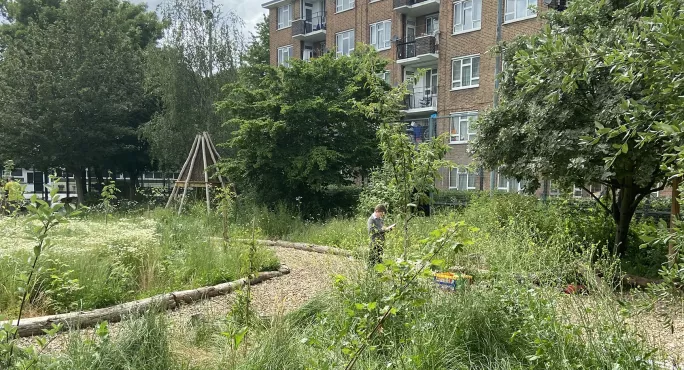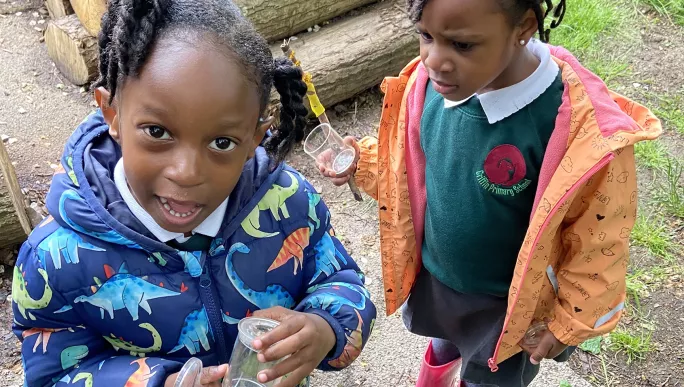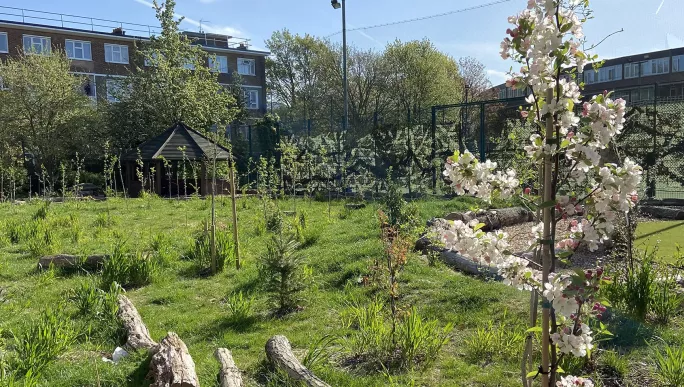How to make forest schools work in cities

“Look, a snail!” an excited little boy tells his parents as I walk towards the reception of Griffin Primary School, in Battersea, south-west London.
“Yes, there are a lot of snails at this school, aren’t there?” his dad replies.
Deputy headteacher Louise Black sees the school’s thriving snail population as a personal victory; for the past couple of years, she’s been at the forefront of a major push towards introducing a forest school at Griffin Primary.
This has not been easy to do. At this inner-city school, there isn’t easy access to green space, and even the small green areas between high-rise flats and other buildings can be unsafe environments for children (often these areas are hotspots for drug- or gang-related activity).
For years, Black and her colleagues had been taking children to the local parks, but during the pandemic this all changed: many children were inside flats with no outdoor space for weeks on end, and having a dedicated area at school for children to be able to access nature became more important than ever.
Black and other leaders lobbied the school’s trust, The Elliot Foundation, to fund the repurposing of a disused running track at the side of the school to turn it into a thriving forest school. Just a couple of years later, it’s an incredible space. Yes, it’s small, but it’s full of greenery (every child planted their own tree), wildlife and opportunities to explore nature.

More on outdoor education and play:
Black admits that the school has been incredibly lucky to have the financial backing of the multi-academy trust - not all schools will be able to access the same support. But she’s unapologetic about using every avenue available to her to make this vision a reality. She is convinced about the mental and physical benefits that forest school can bring, and the research backs her up.
Forest schools: what the research says
For those who may not be familiar, a forest school is a child-centred and child-led learning process that occurs outside, and facilitates play, exploration and supported risk taking.
As a minimum, the Forest School Association suggests 24 weeks, over two terms, with two two-hour seasons a week.
How this is offered can vary from school to school: some schools employ an external forest school teacher, who takes each class for an afternoon, and leave the classroom teacher free for PPA. In other schools, an existing teacher, or teaching assistant, completes the level 3 forest school qualification, and leads the sessions.
This system is widely established across schools in England - but what does the research say about the value of such an approach?
In 2019, academics found that people who had been in “contact with nature” for at least two hours a week were “significantly” more likely to report good health or high wellbeing than those who had not.
A report published by the University of Essex and Mind in 2016 found that people involved in “green care activities” - farming, environmental conservation and social and therapeutic horticulture - had a greatly increased level of social contact and inclusion, as well as a sense of belonging and personal achievement. They also recorded a reduction in depression, anxiety and stress symptoms.
And Lauren Hyams, head of urban nature activities at the Natural History Museum, highlights research by Natural England that shows that the benefits go beyond health, and transfer into how environmentally conscious an individual is.
“The more time you spend in nature as a child, the more likely you are to behave in a pro-environmentally friendly fashion, which is really important for our future sustainability and all the incredibly important conversations we’re having about climate change and biodiversity loss,” she says.
On the ground, the difference that engaging with nature makes to children is obvious, says forest school teacher Rachel Summers, who is based in Walthamstow and works across a number of schools. As a result of children’s participation, she has seen how their confidence improves, along with their gross motor skills and acceptance of the world around them, including the weather.
“So many children miss out on experiencing weather, because if it’s raining, we tend to say, ‘Playtime is inside today.’ But actually, allowing them to experience rain and sleet is really important,” she says. “If you only ever say it’s alright to go outside when it’s good weather, you’re setting them up for a life where they think that happiness hinges on sunshine. But actually, just because it’s raining, it doesn’t mean you can’t enjoy life. Getting children out in all weathers is a good way of training them to have a positive outlook.”
Understandably, some might question the removal of children from the classroom for hours each week - given how much schooling they have missed during the pandemic, and how many are behind on their reading, writing and maths skills. But Black stresses that the skills they gain during the hours they spend outside are absolutely invaluable.

“This is still really, really beneficial and children aren’t going to miss out on learning. Actually, it will help them to improve, and the outcomes will be hopefully stronger as a result of it,” she says. “They gain life skills from lighting fires, and they learn how to solve problems. Outdoor learning is science, it’s maths, it’s teamwork, it’s resilience. And for many parents, I think lockdown has made them realise just how important access to nature is.”
How inner-city schools can access nature
So the benefits are clear, but how can inner-city schools provide these opportunities to children? How do you offer a forest school without a forest - or even any extensive green space?
It can be done, says Summers - but it’s about all looking beyond our expectations of how beautiful nature should be.
“Urban spaces do have wild places within them, but sometimes we allow our eyes to slide across them. We’re all a bit caught up with the idea that for nature to be variable, it has to be somewhere beautiful and special,” she says. “But actually, everywhere is magical for tiny children, and it can be a postage stamp size of wild space. It doesn’t have to be like a nature reserve or something where it’s kind of been planted especially. The fact that it is untamed means there’s that richness to it: there are weeds, bugs, sticks and leaves.”
Once you’ve adjusted your perspective, there are some very easy, practical options for schools of any size, she adds.
1. Reclaim a small patch of unused ground
To find green space in close proximity to any school, Summers heads to Google Maps. Using the satellite view, she explores the area around the school grounds - and nothing is off-limits.
Summers points out that even very small areas of space can be used. “Places like land outside of churches, old graveyards or patches of waste ground really work, especially with tiny children,” she says, because at a young age children will be interested in anything and everything.
If the land appears safe, but doesn’t appear to belong to anyone, get in touch with the local council, Summers advises - and badger it to allow you to claim it as your own. Once you’ve got a dedicated space to return to each week, which you can enhance as you see fit, the wildlife will thrive.
2. Leave places messy
Sometimes, in an effort to introduce elements of nature to a small playground, teachers can do too much, says Summers. Instead of spending money on “making things look like a Pinterest board”, she encourages teachers to leave places messy.
“Nature actually lives in scruffy places, so getting children to bring in a bag of sticks and then dump them all in a corner outside is actually going to be more useful, as far as the school is concerned, because children can find wildlife, and create their own environments,” she says.
“Often in schools, we tidy things away to make it look like something you imagine would make a great forest school, but that’s much harder work. Forest school is about all the mess and muddle beneath trees, so if you can bring in that stuff, and create that in a corner, then that’s brilliant.”
3. Everyday acts of noticing nature
Hyams points towards research carried out by the University of Derby, which found that even simple forms of engagement with nature - what the researchers call “small, everyday connections” - can enhance wellbeing and the likelihood of environmentally positive behaviours. They suggest seven behaviours that teachers could encourage in even the smallest of spaces.
- Watching wildlife (for example bird watching).
- Listening to birdsong.
- Smelling wildflowers.
- Taking a photo/drawing or painting a picture of natural views, plants, flowers or animals.
- Taking time to notice creatures such as butterflies and bees.
- Watching the sunrise.
- Watching clouds.
4. Utilise any space
If schools can’t claim a new space, Black encourages them to use any bit of space they already have. Even on a very small balcony, children can learn how to nurture plants, she suggests.
For example, Griffin Primary has cornered off part of the playground and built vegetable boxes for each class.
“The process of planting, watching the veg grow, and then harvesting it. That kind of thing is really great and is something that everybody can do quite easily,” Black says.
6. Encourage external opportunities
Although forest school predominantly takes place in primary, the need to be connected to nature doesn’t go away when children reach secondary school, says Hyams. Schools could incorporate time in nature when discussing climate change in science, for example - and encourage students to take part in external opportunities.
“Young people who take part in Scouts or the Duke of Edinburgh scheme are going to get a great connection to the outdoors,” says Hyams. “It’s not just up to schools to offer this education. It’s on families and the informal learning sector, too - they need to provide this opportunity for young people at secondary level.”
You need a Tes subscription to read this article
Subscribe now to read this article and get other subscriber-only content:
- Unlimited access to all Tes magazine content
- Exclusive subscriber-only stories
- Award-winning email newsletters
Already a subscriber? Log in
You need a subscription to read this article
Subscribe now to read this article and get other subscriber-only content, including:
- Unlimited access to all Tes magazine content
- Exclusive subscriber-only stories
- Award-winning email newsletters
topics in this article



